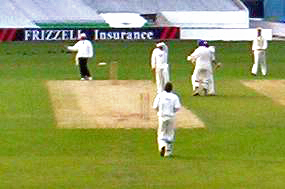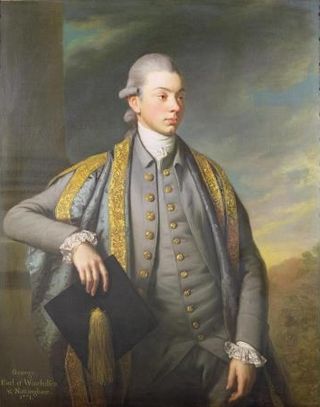First-class cricket, along with List A cricket and Twenty20 cricket, is one of the highest-standard forms of cricket. A first-class match is one of three or more days' scheduled duration between two sides of eleven players each and is officially adjudged to be worthy of the status by virtue of the standard of the competing teams. Matches must allow for the teams to play two innings each, although in practice a team might play only one innings or none at all.

Marylebone Cricket Club (MCC) is a cricket club founded in 1787 and based since 1814 at Lord's Cricket Ground, which it owns, in St John's Wood, London. The club, formerly the governing body of cricket, retains considerable global influence.

Sir Pelham Francis Warner,, affectionately and better known as Plum Warner or "the Grand Old Man" of English cricket, was a Test cricketer and cricket administrator.

Thomas Lord was an English professional cricketer who played first-class cricket from 1787 to 1802. He made a brief comeback, playing in one further match in 1815. Overall, Lord made 90 known appearances in first-class cricket. He was mostly associated with Middlesex and with Marylebone Cricket Club (MCC) as a ground staff bowler.

Leeds/Bradford MCC University, formerly Leeds/Bradford University Centre of Cricketing Excellence, commonly abbreviated to Leeds/Bradford MCCU, is one of six University Centres of Cricketing Excellence supported by the Marylebone Cricket Club (MCC).
The original London Cricket Club was formed in 1722 and was one of the foremost clubs in English cricket over the next four decades, holding important match status. It is closely associated with the Artillery Ground, where it played most of its home matches.

The White Conduit Club (WCC) was a cricket club based on the northern fringes of London that existed from about 1782 until 1788. Although short-lived, it had considerable significance in the history of the game, as its members created the first Lord's venue and reorganised themselves as the new Marylebone Cricket Club (MCC).

George Finch, 9th Earl of Winchilsea, was an English peer, army officer and cricketer who was an important figure in the history of cricket. His main contributions to the game were patronage and organisation but Winchilsea, an amateur, was also a very keen player. Finch served with the 87th Foot at the time of the American Revolutionary War from its formation in 1779 to its disbanding in 1783, with the temporary ranks of major and lieutenant-colonel. Finch was the first president of the Royal Institution, and it was through his influence that it received the endorsement of King George III.
County cricket teams representing Middlesex have been traced back to the 18th century, although for long periods the county was secondary to the London Cricket Club which played at the Artillery Ground. Middlesex teams played at various grounds throughout what is now the Greater London area. Islington and Uxbridge were often used but home matches were also played on Kennington Common and in Berkshire. Middlesex teams were less frequent in the 19th century until 1859 when the Walker family of Southgate became involved in county cricket.
Hampshire county cricket teams have been traced back to the 18th century but the county's involvement in cricket goes back much further than that. Given that the first definite mention of cricket anywhere in the world is dated c.1550 in Guildford, in neighbouring Surrey, it is almost certain that the game had reached Hampshire by the 16th century.
The 1786 English cricket season was the 15th in which matches have been awarded retrospective first-class cricket status and the last before the Marylebone Cricket Club was founded in 1787. The season saw five top-class matches played in the country.

The 1787 cricket season in England is noteworthy for the foundation of Marylebone Cricket Club (MCC) after the opening of Thomas Lord's first ground in the parish of Marylebone, north of London. MCC soon became the sport's governing body with the new ground as its feature venue. The first match known to have been played at Lord's was on Monday, 21 May, between the White Conduit Club and a Middlesex county team. The first match known to involve a team representing MCC was against White Conduit on Monday, 30 July. Including these two, reports and/or match scorecards have survived of numerous eleven-a-side matches played in 1787. Eleven are retrospectively, but unofficially, recognised as first-class.
In the 1788 English cricket season, Marylebone Cricket Club (MCC) published a revised code of the Laws of Cricket, thereby confirming itself as the body in sole charge of the Laws, and taking responsibility for the sport's governance. MCC was then called "The Cricket Club at St. Marylebone", contrasting with its predecessor, the White Conduit Club of Islington, which remained active in 1788. As in 1787, their two teams played against each other at Lord's. A total of fifteen match scorecards have survived and there are brief newspaper mentions of five other matches, including two played under single wicket rules.
Lord's Old Ground was a cricket venue in London that was established by Thomas Lord in 1787. It was used mainly by Marylebone Cricket Club for major matches until 1810, after which a dispute about rent caused Lord to relocate.

Cardiff South Wales MCC University, formerly Cardiff University Centre of Cricketing Excellence, commonly abbreviated to Cardiff MCCU, is one of six University Centres of Cricketing Excellence supported by the Marylebone Cricket Club (MCC). It comprises Cardiff University, the University of South Wales and Cardiff Metropolitan University.
The MCC Bicentenary match was a five-day first-class cricket exhibition match held at Lord's Cricket Ground from 20 to 25 August 1987. The match was in celebration of the 200th anniversary of the Marylebone Cricket Club (MCC), which had been founded in 1787, and was contested between an MCC team captained by Mike Gatting, and a "Rest of the World" team captained by Allan Border. It featured many notable international players: with the exception of Clive Rice of South Africa, 21 of the 22 players had played Test cricket prior to the match.
Lists of English cricketers include:





